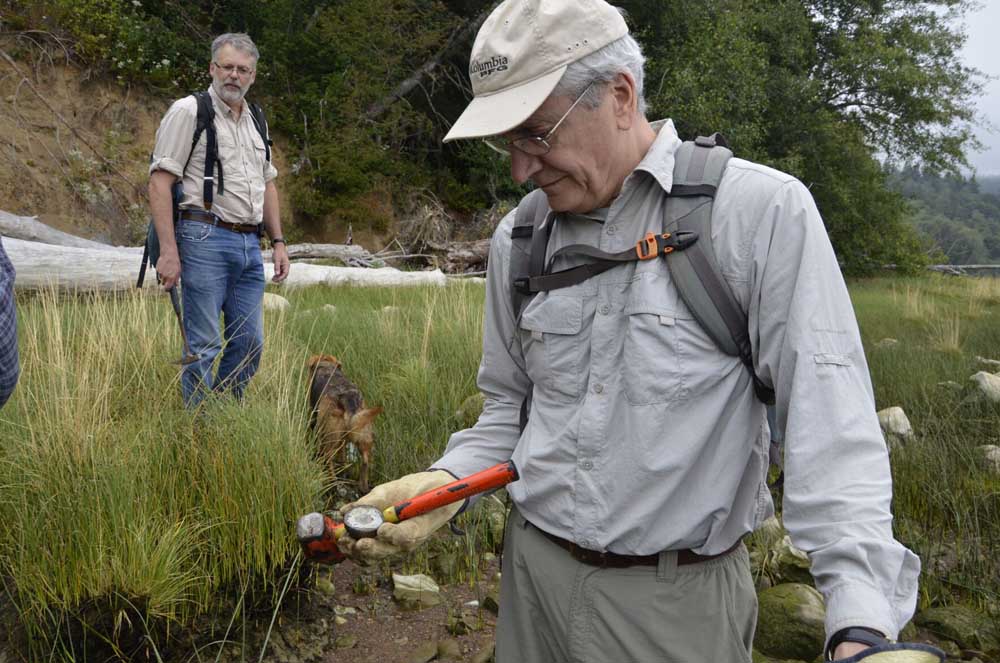Editor’s Notebook: Ancient worlds surround us
Published 12:15 am Saturday, March 8, 2025

- Fossil specialists examine rocks along the Columbia River estuary, where a surprising diversity of ancient species have been discovered.
Like the flickering special effects in the 1960 movie version of H.G. Wells’ “The Time Machine,” past ages unspool around us — if we know how to imagine them.
Trending
It helps to realize Earth’s most recent ice age was at full strength just 20,000 years ago — a mosquito’s wing-beat in the immensity of world history.
A glacier thousands of feet deep covered what became Seattle. It extended south past Olympia. With so much water locked up in ice, the Pacific Ocean shoreline stretched far away to the edge of the continental shelf. This now-drowned coastal plain was home to Columbian mammoths, giant ground sloths, caribou — and people. Stand on our beach, gaze west and picture a realm out to the horizon — a complex habitat dominated by willow and alder, eventually transitioning to cottonwood, hemlock and spruce.
I think of this rich, ghostly forest beneath the waves while walking in today’s coastal dunes, which are also fated to vanish beneath the surf someday. The ocean giveth and the ocean taketh away.
Trending
Recycling atoms
What kid doesn’t love a good fossil? I sure did, and still do.
Dinosaurs were my go-to topic for kindergarten small talk. Decades later, one friend recalled that members of our gang were dumbfounded both by my dinosaur trivia and by how pretty the ladies were in a Playboy magazine another boy purloined from his dad’s collection and brought for show-and-tell — noticing they were wearing fewer clothes than mommas usually wore in 1963. But at age 5 and for a few years beyond, my main passion was dinosaurs.
I only ever found a couple of definite dinosaur bones — in a small, odd-colored deposit emerging out of an arid hillside near what we used to call Johnny Lee’s Corner. The best was a knuckle bone the size of a small cantaloupe; it sat on a shelf in my boyhood bedroom but went astray somewhere during my migration into adulthood. Tinted vivid red by mineral deposits, I imagined it still surrounded by bright blood inside a living creature, perhaps hunting for a little mammal such as myself.
These early experiences meant I never harbored illusions about the permanence or entitlement of humanity. We live in a world where the eons turn ocean bottoms into mountaintops, and pieces of mighty monsters become knick-knacks for small boys. In a universe where nothing ever really goes to waste, the air we breathe and the canned peas we eat for dinner contain uncountable millions of atoms that once were parts of velociraptors. The persistence of life is as reassuring as it is humbling.
Pioneering scientists
There are wonderful examples of the comings and goings of species right here along the Columbia River estuary, where a surprising diversity of fossils erode from decaying riverbanks and hillsides. Local geological terms like the Astoria Formation and Lincoln Creek Formation deserve to be included in local high school lesson plans.
The first men known to admire our neighborhood fossils were Scotsmen John Scouler (1804-1871) and David Douglas (1799-1834). They arrived together from England on the Hudson’s Bay Company’s ship William and Anne, and entered the mouth of the Columbia River on April 7, 1825, according to www.historylink.org.
Douglas famously concentrated on botany, with the Douglas fir named in his honor around the time he was gored to death by a bull in Hawaii. Scouler, the ship’s surgeon, “would eventually have a long career as a naturalist and professor at Andersonian University in Scotland, where his interests included geology, anthropology and botany. Despite his many contributions to natural and human history, Scouler is often overlooked relative to Douglas, who, although he died young, is honored by more than 80 species bearing his name,” HistoryLink observes.
While here, Scouler wrote about finding many ancient clam shells, likely on what’s now the Washington shore of the Columbia, opposite Astoria.
Perhaps similarly plentiful fossil deposits remain to be discovered elsewhere in our estuary counties. But for now, Knappton, near where the giant Simpson sawmill once stood, is considered remarkable.
Fossil penguin
According to an article by Sarah Richards of Columbia Land Trust, in 1978 amateur paleontologist Jim Goedert and his wife, Gail, discovered the skull and teeth of a primitive whale dating back 25 million years. Back then, this area was anything up to 3,000 feet beneath the waves. Besides clams, deep-sea corals can be found.
Richards says the whale skull the Goederts came across — as well as many other finds from the Pacific County site — reside at the Natural History Museum of Los Angeles County, the Burke Museum at the University of Washington, the Smithsonian Institution’s National Museum of Natural History, and other museums throughout the world, from Poland to Japan.
“What’s so significant about southwest Washington is that there’s no representation of the fossil record for many species of the geological time period anywhere else in the region or in the world,” Jim Goedert said.
Among Knappton’s unique species is its namesake, Diomedavus knapptonensis, an albatross described in a scientific paper as “smaller than all extant albatrosses and [which] represents the oldest published fossil albatross from the North Pacific Basin.” Bones of another species, informally called the “Astoria Formation albatross,” suggest it could walk quite well. This contrasts with existing albatrosses, which adeptly sail over the ocean swells for months at a time, rarely tripping around on land except to mate and rear young.
Fond as I am of albatrosses — a trait shared with my literary hero Stephen Maturin — my favorite bygone local species is Olympidytes thieli. It was discovered by Bruce Thiel while looking for fossilized crab. German fossil bird expert Dr. Gerald Mayr says it “may have been about the size of a larger extant penguin, such as the Emperor Penguin” — 4 feet tall.
What fun it would be to still see them around.
Note that most local fossils mentioned here can only be recognized by experts and collecting should be left to them. Much of the Columbia River shoreline is privately owned and accessible only with permission. If you find something you think is significant on an outdoor journey, leave it in place and contact your state’s appropriate official.
Matt Winters is the regional editor for The Astorian and the Seaside Signal.






